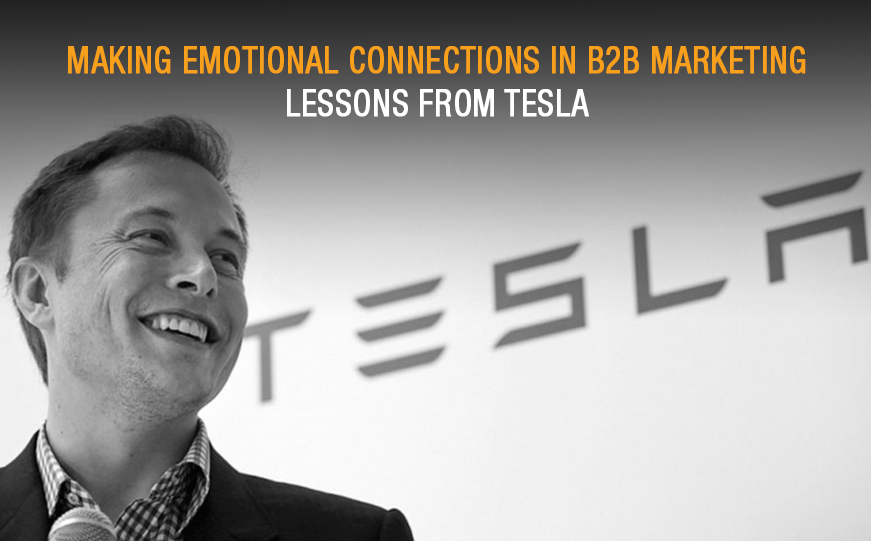Just this week, Tesla’s per share price crossed the $1000 threshold and — in so doing — brought the electric vehicle’s market valuation into the trillion dollar club. That’s a distinction shared by a mere six corporations in history. And quite the achievement for a 50-year-old immigrant from South Africa.
Yes, Elon Musk is the quintessential disruptor. He’s a very public figure who wears his heart on his sleeve… and knows how to court controversy to get press attention. So, what are the business-to-business (B2B) marketing lessons — that every building product brand can learn — from his meteoric rise and varied ventures?
Simply this: an emotional connection with audiences is Elon Musk’s most valuable promise.
Of course, establishing and building emotional connections with consumers — like homeowners — has always been at the heart of business-to-consumer (B2C) marketing. Yet, for B2B marketers… it’s long been assumed that content must remain rational. And non-emotional.
But it’s not such a binary distinction.
Ultimately, B2B marketers need to reach trade channel decision makers. “Repeat influencer” audiences… like builders, contractors and architects. And often, those decisions may be influenced by purchasing committees, consultants and corporate procurement procedures… without a lot of room for “warm and fuzzy” marketing interactions.
However, we cannot afford to forget that all brands must promise to meet the emotional needs of their audiences. And that, at our core… we’re all motivated by emotions. And connected to each other by empathy.
Going deeper
When in the role of a B2B marketer, and as a matter of best practices, we always want to learn as much as possible about our audiences’ rational preferences. Their logical needs. And their transactional behaviors.
Yet, it’s also important to consider an audience’s emotional needs. To understand their motivations. And think about what keeps customers and prospects “up at night.”
Given the current business climate — where everything from delivery schedules to supply chains have been disrupted — no brand can afford to ignore paying attention to the emotions, and top-of-mind anxieties, behind purchasing decisions.
Re-thinking the B2B approach
Recently, the Content Marketing Institute hosted a Demand Gen Summit. At that event, Marketing Interactions’ Ardath Albee and Gurdeep Dhillon — formerly Adobe Digital Experience’s Global Head of Commercial Marketing – discussed ways to incorporate emotional intelligence into B2B content marketing.
“We have an opportunity to rethink the way we’re presenting our products — to make them more interesting and to change the whole conversation and dialogue around them,” said Ms. Albee. “The more you can do with that, the more trust you are accumulating.”
“Increasingly, the best way for content marketers to build that trust is by demonstrating deeper awareness and understanding of the positive outcomes and experiences our audience wants to achieve, not focusing on the transactional behaviors we want to drive.”
As an example, Albee pointed to a question posted in a LinkedIn discussion group at the beginning of May 2020: What do B2B customers want to hear from businesses in response to the pandemic?
While the responses included typical business concerns, like how to keep revenue on track — and how to ensure businesses remained competitive — they also reflected more personal, emotion-driven concerns. For example, job security. Family safety. And uncertainty about the financial future.
The conversation revealed that customers and prospects are looking for brands to help them feel more confident. And more in control of their work priorities. What’s more, they want brands to help them address even bigger questions, such as “what does the future look like?” And “what should we plan for?”
Filling the bucket
During his part of the presentation, Gurdeep Dhillon offered a simple question for gauging whether a brand is creating empathetic content conversations: “Are you filling your customers’ bucket or draining it?”

Dillon shared a story about Project Cornerstone, an anti-bullying program he participated in. The premise was that everybody walks around with an invisible emotional bucket. When that bucket is full, they feel great — confident, fulfilled and full of purpose. On the other hand, when that bucket is empty, they feel anxious. And sad, with a sense of loss. People with empty buckets — in this case, bullies — try to fill their buckets by dipping into someone else’s.
“[Marketers] have our own buckets we want to fill,” Dillon explained.
“We want leads, we want pipeline, we want revenue. But our customers have buckets too. We can’t fill ours by dipping into theirs — pushing our products and messages onto the audience. The only way to fill our buckets is by filling theirs too by delivering micro-moments of value — relevant content, ideas and answers to their most important burning questions over time. Do you produce the right pieces of content to fill your audience’s bucket?”
What does this mean for building product marketers?
While playing to an audience’s emotions is more commonly used in B2C marketing… if you really think deeply about it, B2B audiences share the same fundamental human priorities. And are just as interested in seeing their experiences reflected in the content they consume.
So, what can B2B brands do to accomplish a greater sense of empathy, emotion and shared meaning in content marketing?
Start by positioning your building product brand’s benefits… in terms of shared audience experiences. And create stories where the customer — not the brand — is the hero. In doing so, audiences will experience your brand’s promise… as a relationship, founded on understanding your audiences’ goals. And as a partner who provides the tools to help customers and prospects achieve those goals.
Find a deeper understanding of what audiences are going through. Not just what they want to accomplish… but what motivates them to accomplish it. True brand empathy is about creating a shared journey.
Here are some tips for integrating empathy and emotion into your B2B marketing campaigns.
Go beyond business priorities. Take the conversation further in sales and marketing campaigns, to create “talkable” moments around your audiences’ professional aspirations. For example, how they can advance their careers. How they can feel increased pride in their work. Or how they can more effectively demonstrate the value that their team contributes… to their company’s success.
Keep it positive. After a challenging past year-and-a-half, all customers and prospects are seeking similar signals of hope. And a clear path forward. They are looking for confidence — with reassurance and guidance — in pursuing opportunities. So, rather than dwelling on the stresses and challenges that stand between them and their goals, why not be the inspiration?
Highlight small improvements to build momentum. In life, people have an easier time embracing smaller, simpler steps. Instead of trying to solve complicated problems or accomplishing sweeping changes. The same often holds true in business. Create content around the opportunities that target what audiences can achieve now. Show them the possibilities that small improvements can lead to… and guide them toward the longer-term outcomes.
Getting to the heart of the matter
Most brand advocates claim that they seek to build close, trusting relationships with their audiences. That’s why it’s important to create campaigns and stories that truly resonate. And are situationally relevant. As well as emotionally intelligent. These are among the best ways to build strong foundations and forge truly meaningful business partnerships.
Looking to bring more empathy and authenticity to your sales and marketing campaigns? Whether you’re ready to launch a new program — or enhance momentum — K&A is here to help. Send an email to Steve Kleber at sk@kleberandassociates.com to learn more.




